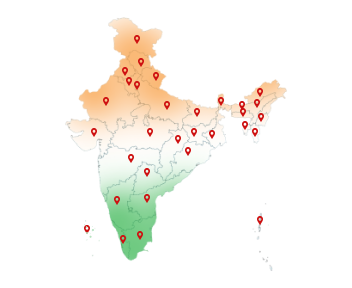18-Sep-2024
DSC for GST: Compliance Made Efficient
Goods and Services Tax (GST) is a single tax system introduced in India on July 1, 2017. It replaced Central Excise Duty, Service Tax, and VAT. Moreover, GST simplifies and unifies the tax process, making it easier to manage.
Furthermore, the GST system is managed by the Goods and Services Tax Council, which includes representatives from central and state governments.
Businesses often need to use Digital Signature Certificate (DSC) to ensure smooth compliance with GST regulations. It ensures your GST returns and documents are securely filed and verified. Make sure you have a valid DSC for GST for easy GST compliance.
Is DSC required for GST registration for Proprietorship?
No, Digital Signature Certificate is not required for GST registration for a proprietorship. Proprietors can use their Aadhaar number for the registration process. However, DSC is necessary for certain other GST-related activities, such as filing GST returns and other documents digitally. For these tasks, a DSC for GST ensures secure and verified submissions.
Requirements for GST registration for Proprietorship
To register a Sole Proprietorship, the following documents are required:
Aadhaar Card
PAN Card
Proof of Registered Office
Bank Account Details
For a sole proprietorship firm, the following registrations are typically required:
SME (Small and Medium Enterprise) Registration
Shop and Establishment Act License
DSC Required for GST Registration for Company?
No, as per the new update, DSC is no longer mandatory for GST registration for companies. Companies can now file GST returns and respond to notices using an Electronic Verification Code (EVC), which allows the authorized signatory to sign documents on the GST Portal without needing a DSC.
Want to want a full update about DSC fro GST in 2025? Here is a complete guide, from GST portal login, DSC registration, filing and maintenance. READ HERE!
Proprietorship GST Registration
Follow the below-mentioned steps for GST registration for a sole proprietorship:
Step 1: Go to the GST Portal.
Step 2: Start the Registration
1. Click "Services" > "Registration" > "New Registration”.
2. Choose "New Registration" and fill in your details:
(a) Select "Proprietor" as the taxpayer type.
(b) Enter your State, District, Business Name (as per PAN), PAN number, Email ID, and Mobile Number.
Step 3: Verify your contact details by entering the OTP sent to your mobile and email.
Step 4: After verification, you will receive a Temporary Reference Number (TRN). Save it for later use.
Step 5: Log In with TRN
Go back to the GST Portal.
Click "Services" > "Registration" > "New Registration”.
Select "Temporary Reference Number (TRN)" and enter your TRN.
Verify with the OTP again.
Step 6: Fill Out the GST Registration Form
1. Complete the form by entering:
(a) Business Details (Name, PAN, trade name).
(b) Proprietor Details (Personal information).
(c) Business Address (Your main business location).
(d) Bank Account Details (Account number, IFSC code).
(e) Goods and Services (What you sell or provide).
Step 7: Upload Your Documents
1. Upload scanned copies of:
(a) Your Photograph
(b) Aadhaar Card and PAN Card
(c) Business Address Proof (like a rent agreement or electricity bill)
(d) Bank Statement or Canceled Cheque
Step 8: Review your form, then submit it using EVC or DSC.
Step 9: Once approved, you'll receive your GSTIN (Goods and Services Tax Identification Number) and your GST registration certificate.
Securely submit your forms with a DSC for GST and ensure compliance. Choose a reliable and efficient solution to protect your submissions.
What's the difference between submit with DSC or EVC on GST Portal?
On the GST Portal, both DSC and EVC are used to authenticate and submit documents, but they differ in how they work and who can use them.
1. Digital Signature Certificate (DSC):
DSC for GST is a digital equivalent of a physical signature, issued by a certifying authority. It is used to sign documents electronically in a secure and legally recognized manner.
It is commonly required for companies, LLPs, and other businesses where formal, secure authentication is necessary.
This uses strong encryption to ensure that the documents are securely signed and cannot be tampered with.
Previously companies needed to have DSC, but now they have an option to use EVC instead.
Primarily used for signing GST returns, registration applications, and other submissions requiring legal authenticity.
2. Electronic Verification Code (EVC):
EVC is a code sent to the registered mobile number or email of the taxpayer, used to verify the identity of the person submitting the document.
Individual taxpayers, sole proprietors, and now companies can use EVC for submissions on the GST Portal.
It does not provide strong security like DSC, as it relies on OTP-based verification to authenticate the user.
It is optional for most users, including companies, as an alternative to DSC.
This is used for filing GST returns, registration, and other forms where a DSC is not necessary or preferred.
Want to have a higher level of security? Buy DSC for GST from Capricorn CA.
Key Differences:
Security: DSC provides a higher security level than EVC because it involves encryption and a digital certificate.
Convenience: EVC is generally more convenient as it does not require special software or hardware. It just needs access to the registered mobile number or email.
Applicability: DSC is more suited for situations requiring high legal validity and security, while EVC is easier for general filings and accessible to more users.
Conclusion
DSC for GST offers enhanced security and legal validity. It ensures that your submissions are secure and authenticated. This makes it an ideal choice for businesses.


